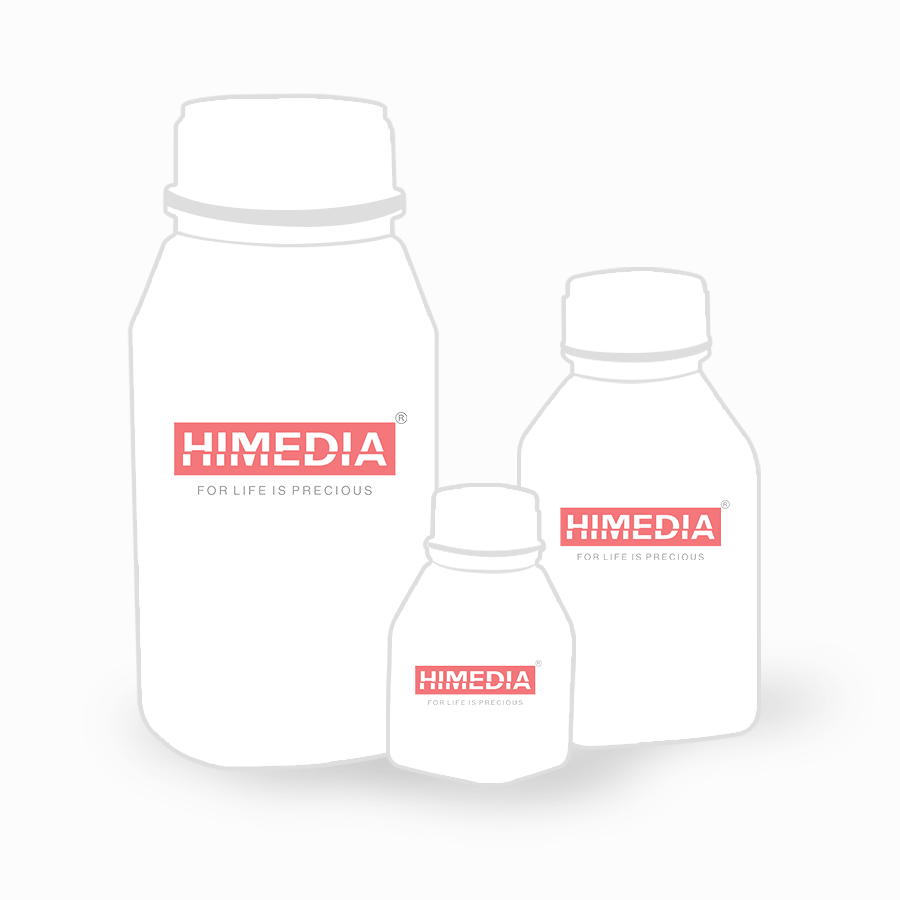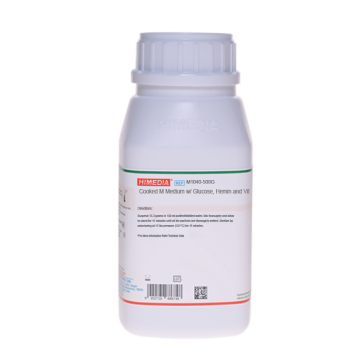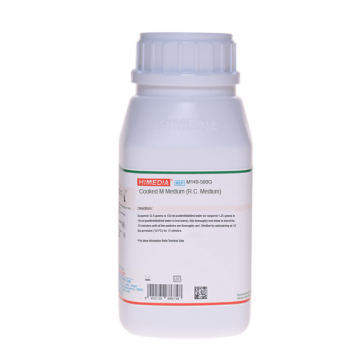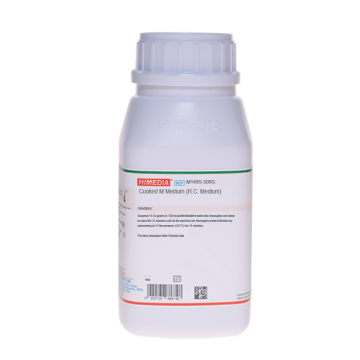 Your enquiry has been submitted
Your enquiry has been submitted
Cooked Meat Medium, Modified (Revised as Cooked M Medium, Modified)
Intended Use
Recommended for isolation of Clostridium species in accordance with FDA BAM, 1998.
Composition
| Ingredients | Gms / Litre |
|---|---|
| Part A | |
| HMH Peptone B # | 98.000 |
| Proteose peptone | 20.000 |
| Dextrose (Glucose) | 2.000 |
| Sodium chloride | 5.000 |
| Part B | |
| Tryptone | 10.000 |
| Sodium thioglycollate | 1.000 |
| Soluble starch | 1.000 |
| Neutral red | 0.050 |
Final pH (at 25°C): 6.8±0.2
# Equivalent to Beef heart, solids
**Formula adjusted, standardized to suit performance parameters
Directions
Part A: Add 1g directly into 20×150mm test tubes
Part B: Suspend 14.05 grams of Part B in 1000ml purified / distilled water.
Complete Medium: Transfer 15ml of Part B medium into the tube containing 1 gram of Part A. Allow to stand so that all the meat particles are rehydrated. Sterilize by autoclaving at 15lbs pressure (121°C) for 15minutes.
Principle And Interpretation
Cooked Meat Medium, Modified is prepared in accordance with FDA BAM, 1998 (1) for the cultivation of Clostridium species, particularly Clostridium perfringens and Clostridium botulinum from food products. Clostridium is a large genus of gram-positive spore-bearing anaerobes that are normal inhabitants of the soil and are causative agents of food poisoning. Detection of C. perfringens, C. sporogenes and Clostridium botulinum is of significance because of their ability to produce enterotoxin alpha and botulinum toxins responsible for gas gangrene and botulinism. Cooked Meat Medium was initially developed by Robertson (6) for the cultivation of certain anaerobes isolated from wounds. The medium can be used when the inoculums strength is low and also for maintenance of cultures. This allows the growth of mixed cultures of bacteria without affecting the performance of the other (1).
Cooked Meat Medium contains HMH Peptone B, Proteose peptone which provides carbon, nitrogen substances, amino acids and other nutrients. HMH Peptone B also contains glutathione, a reducing substance that permits the growth of obligate anaerobes (5). The sulphydryl groups, which impart reducing effect, are more available in denatured protein and hence cooked meat is added in the medium. Dextrose allows rapid and heavy growth of anaerobic bacteria in a short time. Sodium Thioglycollate lower the oxidation-reduction potential of the medium. Starch provides the complex carbohydrates that help the growth of anaerobes.
Growth in this medium is indicated by turbidity and/or colour change in the medium. Clostridium perfringens ferment dextrose, changing the colour of the medium from pink to yellow. Some are late fermenters. Blackening and disintegration of the meat particles indicate proteolysis. It is recommended to used the media in the day of preparation itself; otherwise it should be boiled or steamed for a few minutes and allowed to cool without agitation before inoculation. Inoculation should be made near the bottom of the tube in the meat particles for anaerobic cultures. Aerobes grow at the top whilst more anaerobic species grow deeper in the medium. Representative 25g of food sample is homogenized in 225ml peptone dilution fluids.
Appropriate dilutions are prepared and inoculated on TSC Agar for plate count of viable C. perfringens. Simultaneously 3 or 4 CMM tubes are inoculated with 2ml of homogenates solution as back up for preceding plating procedure. Incubation is carried out at 35°C for 24-48hrs and examined microscopically for morphology appearance as tennis racket shaped Clostridium cells.
Type of specimen
Food samples
Specimen Collection and Handling
For food samples, follow appropriate techniques for sample collection and processing as per guidelines (7). After use, contaminated materials must be sterilized by autoclaving before discarding.
Warning and Precautions
Read the label before opening the container. Wear protective gloves/protective clothing/eye protection/ face protection. Follow good microbiological lab practices while handling specimens and culture. Standard precautions as per established guidelines should be followed while handling specimens. Safety guidelines may be referred in individual safety data sheets.
Limitations
- Further isolation on selective media is required.
- For complete identification, biochemical and serological tests must be carried out.
Performance and Evaluation
Performance of the medium is expected when used as per the direction on the label within the expiry period when stored at recommended temperature.
Quality Control
Appearance Part A : Brown granules Part B : Light yellow to pink homogeneous free flowing powder
Colour and Clarity of prepared medium Red coloured slightly opalescent supernatant over insoluble granules
Reaction Reaction of medium [(6.67% w/v) Part A and (1.41% w/v) Part B] at 25°C. pH : 6.8±0.2
pH 6.60-7.00
Cultural Response Cultural characteristics observed after an incubation at 35-37°C for 24-48 hours under anaerobic conditions.
| Organism | Inoculum (CFU) | Growth |
|---|---|---|
| Clostridium perfringens ATCC 12924 | 50-100 | luxuriant |
| Clostridium botulinum ATCC 25763 | 50-100 | luxuriant |
| Clostridium sporogenes ATCC 11437 | 50-100 | luxuriant |
Storage and Shelf Life
Store between 10-30°C in a tightly closed container and the prepared medium at 15-25°C. Use before expiry date on the label. On opening, product should be properly stored dry, after tightly capping the bottle in order to prevent lump formation due to the hygroscopic nature of the product. Improper storage of the product may lead to lump formation. Store in dry ventilated area protected from extremes of temperature and sources of ignition. Seal the container tightly after use. Product performance is best if used within stated expiry period.
Disposal
User must ensure safe disposal by autoclaving and/or incineration of used or unusable preparations of this product. Follow established laboratory procedures in disposing of infectious materials and material that comes into contact with sample must be decontaminated and disposed of in accordance with current laboratory techniques (3,4).
Reference
- Collins, CH., Lyne, PM. and Grange, JM. 1985. Microbiological Methods.
- FDA, U.S. 1998. Bacteriological Analytical Manual. 8 ed. Gaithersburg, MD: AOAC International.
- Isenberg, H.D. Clinical Microbiology Procedures Handbook 2nd Edition.
- Jorgensen, J.H., Pfaller, M.A., Carroll, K.C., Funke, G., Landry, M.L., Richter, S.S and Warnock., D.W. (2015) Manual of Clinical Microbiology, 11th Edition. Vol. 1.
- MacFaddin, J. F. 1985. Media for Isolation-Cultivation-Identification-Maintenance of Medical Bacteria vol. 1. Baltimore: Williams and Wilkins.
- Robertson. 1916. J. Pathol. Bacteriol, 20(327).
- Salfinger Y., and Tortorello M.L. , 2015, Compendium of Methods for the Microbiological Examination of Foods, 5th Ed., American Public Health Association, Washington, D.C.
| Product Name | Cooked Meat Medium, Modified (Revised as Cooked M Medium, Modified) |
|---|---|
| SKU | M1870 |
| Product Type | Regular |
| Physical Form | Powder |
| Origin | Animal |
| Packaging type | HDPE |
| References | 1.FDA, U.S. 199 |
| Customized Product Available | No |








